
Blue Means Go — Colors in Japan
Blue and Green — Colors in Japan
What color is the sky in Japan?
That's a silly question.
The sky is blue.
The same as the grass, and trees,
and matcha tea,
and many vegetables.
The English language splits a range of hues into what
we call "blue" and "green".
Japanese considers that range to be a single color.
Don't feel smugly superior for your simple color-splitting.
Russian and Greek speakers think that English speakers are
strange for lumping two obviously different colors
into a vague category of "blue".
We're crossing the street in the
Akihabara
district of Tōkyō.
There's a signal telling us to walk.
I would call this one green, but older signal lights are
noticeably further into what English speakers call
the blue part of the spectrum.
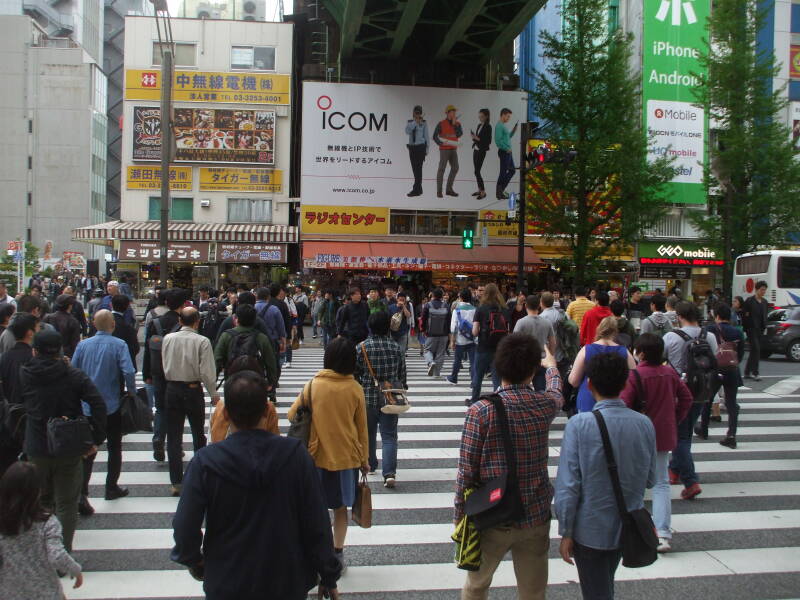
How Many Colors Are There?
It depends on who you ask. English speakers would say that both of these are blue, one box a light blue or sky blue, and the other dark blue.
|
голубой
γαλάζιος #00BFFF (195°, 100%, 100%) |
синий
μπλε #004DFF (222°, 100%, 100%) |
A Russian speaker, however, would insist that those are two distinct colors, as different from each other as red is from green, named as labeled: голубой or goluboy on the left, and синий or siniy on the right.
Color in HTML
According to the
Russian Wikipedia page,
goluboy is similar to #00BFFF in RGB,
or (195°, 100%, 100%) in HSV,
while
siniy is similar to #004DFF in RGB,
or (222°, 100%, 100%) in HSV.
Greek
Greek does something similar. The word μπλε means blue. You could say ανοιχτό μπλε to mean light blue, or σκούρο μπλε to mean an especially deep blue or dark blue. But there is a dedicated standalone word γαλάζιος meaning light blue. Μπλε is like English dark blue or Russian синий, γαλάζιος is like English light blue or Russian голубой.
Many other languages join Japanese in using a single term to describe what English splits into blue and green — Thai, Vietnamese, Lakota Sioux, Mayan languages, Tibetan, Pashto, and others.
Guy Deutscher's Through the Language Glass is a fascinating description of how different languages handle the concept of color in so many ways.
Some people use claims of "Those people don't have a word for X" to make a group of people seem inferior and strange. Ronald Reagan claimed in October 1985 that the Russian language had no word for "freedom", ignoring the obvious свобода (or svoboda) and numerous derivatives. Before long you're going down a rabbit hole and abusing the Sapir-Whorf hypothesis to "prove" crackpot theories. The Language Log debunks journalists searching for explanations of how Americans are so independent while East Asians are not.
Meanwhile, American English has no words for "fair living wage", or "ethical business practices", or "trustworthy law enforcement". There are no single words for those concepts. Each of them can only be described by a multi-word phrase. That doesn't necessarily mean that the culture has no understanding of those concepts.
Steven Pinker's The Language Instinct debunks the myth of "The Inuit people have a an enormous number of words for 'snow'."
Is brown a color? Maybe. However, shades of brown are exactly the same hues as a range of yellow through orange to red, just darker.
| yellow to red ↓ |
light to dark → |
||||||||
Homer famously told of the "wine-dark sea" in the Odyssey. There is no mention of blue in the Odyssey, and Homer also described honey as being green.
Hebrew has the word תְּכֵלֶת or tekhelet, referencing a shade of blue variously described in English as "blue-violet" or "turquoise" or simply "blue". It appears 48 or 49 times in the Hebrew Bible, depending on the text version, in descriptions of the tapestries in the Tabernacle, the clothing of the High Priest, and personal ceremonial garments. Shades of deep blue and purple have always been considered especially auspicious, as they are generally produced from uncommon and thus expensive raw material.
The Bible does not describe the source of the tekhelet dye, or how to produce it. The Talmud says that it comes from a marine creature called the Ḥillazon. Ezekiel 27:7 can be read as saying that the Ḥillazon is a shellfish from the Aegean sea.
By the mid 3rd century BCE Koine Greek translated tekhelet as ύακίνθος or hyakinthos, the violet-blue to blue-purple of the hyacinth flower.
In the 20th and 21st centuries, scholars have written theses on the identity of the tekhelet dye's source and thus its actual color.
A language starts by just distinguishing dark and light. Red is typically the first color to be added. Then, typically, yellow followed by green, but some languages distinguish green before yellow. Blue then follows, then brown, and then other colors, at least according to the studies that are usually quoted.
English only used "orange" to name a fruit, based on its French name, which was based on its Arabic and Sanskrit names. Artists referred to the color between yellow and red as "yellow-red". "Orangish" appeared in the late 19th century, and the adjective "orange" naming a color only came into common use in the early 20th century.
Anyway, in the Japanese language and culture あお or ao includes what English speakers call blue and green.
The word みどり or midori appeared during the Heian period of 794–1185, and until recently it referred to a shade of ao. It was only after 1945 and the end of World War II that Japanese textbooks distinguished between the English concepts of "blue" and "green", using midori or the English loanword グリーン (or gurīn) for "green".
Don't worry, Japanese has plenty of traditional colors for your kimono design.
Traffic Signal Laws
There have been international agreements governing motor vehicle traffic. The Geneva Convention on Road Traffic and the accompanying Protocol on Road Signs and Signals were written in 1949 and came into force in 1952. Japan was one of 101 parties to the convention.
Then the Vienna Convention on Road Traffic and the accompanying Convention on Road Signs and Signals were agreed upon in 1968 and came into force in 1977. Japan has not signed that agreement, although neither have the U.S. or Canada.
Japan has had traffic signal lights since one was set up at Hibiya Crossing in Tōkyō in 1930. In 1973 a national government mandate declared that the lights signaling "go" should be the bluest possible shade of green. Official documents still refer to the "go" traffic lights as ao or "blue" rather than midori or "green".
Blue-green signal lights are actually a very good idea, because Red-green color blindness is the most common form of color blindness. It affects up to 8% of males and 0.5% of females of Northern European descent.
British rail signal lights intentionally use deep red, pure yellow, and blue-green to assure the best discrimination between them.
Let's See Some Japanese Traffic Signal Lights
Here's a closer look at a pedestrian signal light in the Akihabara district of Tōkyō.
Eight-segment bars count down the remaining time. This signal is 6/8 or 75% of the way through the walk period.
Pay attention when crossing! When the bar goes to zero segments the red "Don't Walk" silhouette lights, as do the full red bars below. But the cross traffic gets a simultaneous green light, and they start moving! Japanese drivers assume that you are going to follow the rules and obey the lights. Some times you really have to hustle to get across during the walk period.
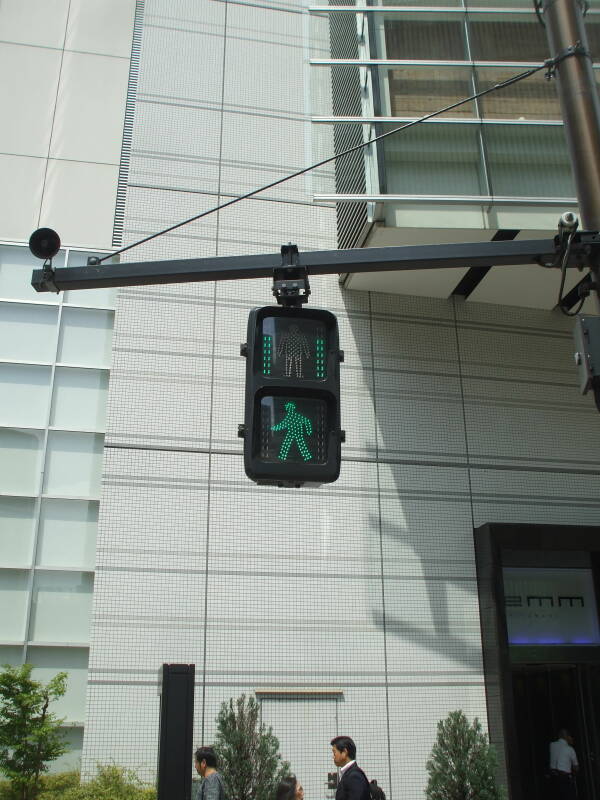
Here's a "Don't Walk" signal counting down in the Asakusa district of Tōkyō. The pedestrian signals start with full vertical bars that shrink down as the time expires. Be out of the street before the last segment segment goes out, because the cross traffic gets their go signal then.
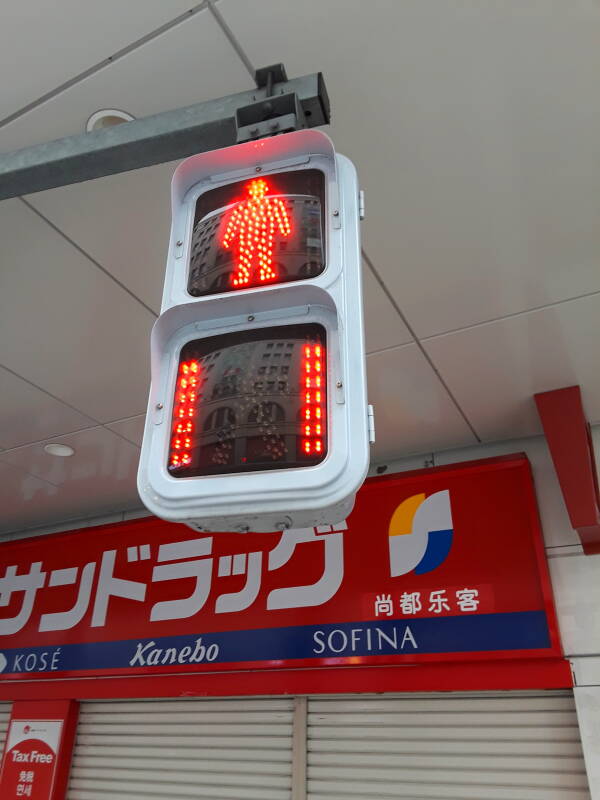
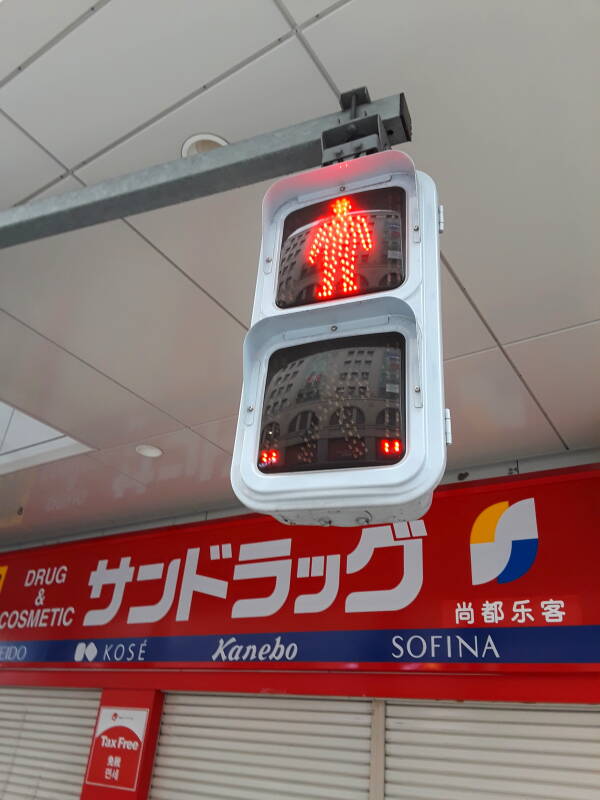
Most LED-based traffic and pedestrian signals tend to be what English speakers would call green, only very slightly blue-green. My guess is that the manufacturers want to sell them world-wide, and don't want to be limited to a blue-tinted Japanese market.
Some LED signals, like this one in the Kappabashi area of Tōkyō, are a little toward blue-green.
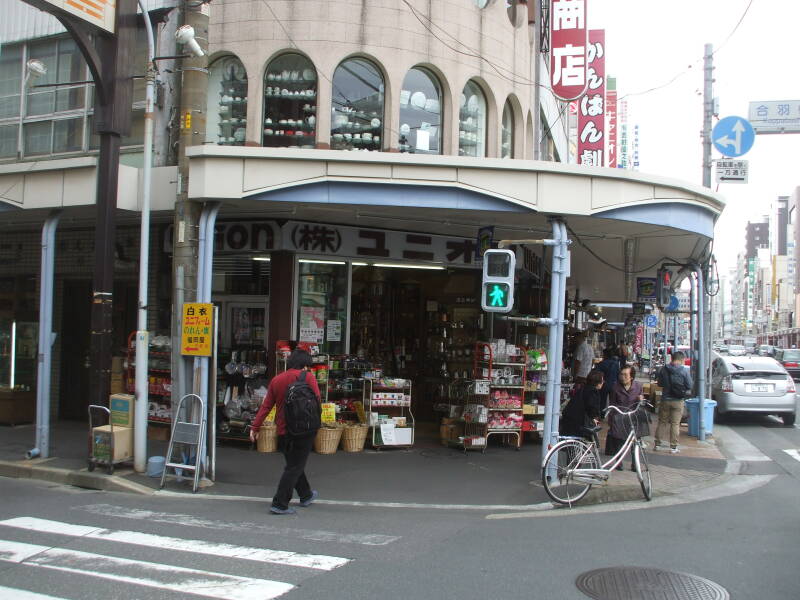
For truly blue signals, look for older ones with colored glass lenses. For example, this pedestrian signal in Ise.


Here's another clearly blue-green pedestrian signal in Ise.

In Nagasaki, seen below, we're back to bright green LED signals.
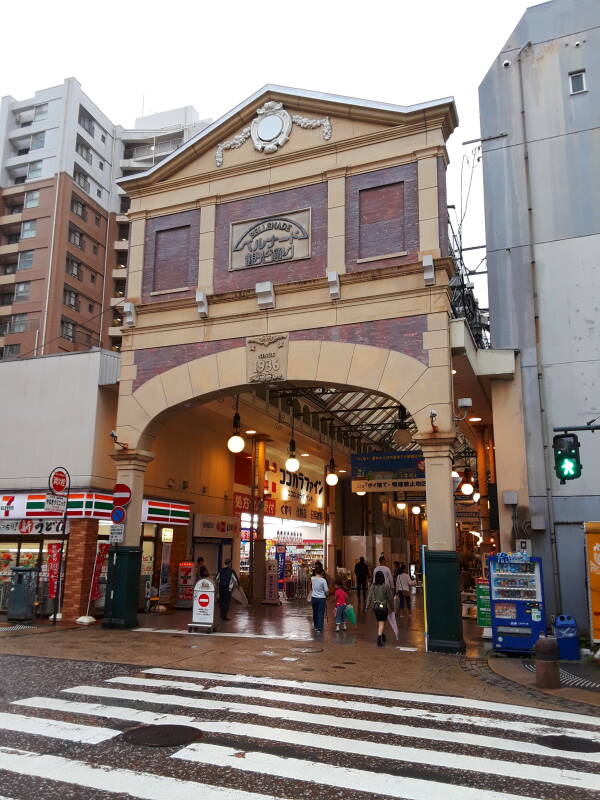
In Ueno park in Tōkyō, near the National Museum, we have a nice view of the sky, trees, a sign, and a walk signal, all of them ao or "blue" as described locally.


Below is the famous scramble crossing in the Shibuya district of Tōkyō. You have to walk quickly to get across some of the longer diagonal paths at Shibuya.

The above is specific to travel logistics. Maybe you're looking for information on specific places in Japan.






































